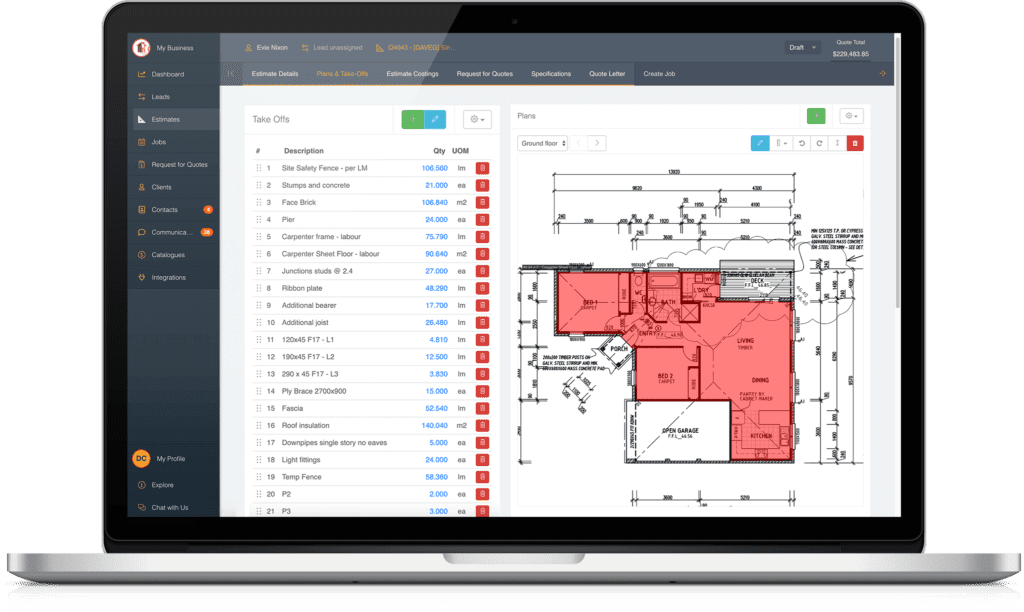Investing the time to correctly quote your work is vital in the current industry climate. This includes your initial takeoff, any special conditions or clarifications, and a realistic expiry date. It also includes understanding what the client wants you to deliver. Although you are not usually bound by a quote, it does help the process go smoother if there are not hidden extras when you go to contract.
Use a template
Putting together a complex quote can be time consuming and hard to get accurate. Only you can bring the expertise of reading plans properly, but setting up a good estimating template will make sure you don’t miss anything
A good template could include:
- Any preliminary costs
- Any admin costs
- Insurances
- Equipment hire items
- A subsection for each common element for your trade
Create a template for each major type of job you quote. If you are not sure what to include in them, review the last 5 quotes you’ve done and bring in all the items you’ve used.
When it comes to creating the new quote, just copy your template and delete any lines you don’t need. The rest acts as a checklist so you don’t miss anything. It can be really helpful when you are quoting off little sleep.
Use the right takeoff tool
There are lots of strong take-off tools on the market currently, from specific trade tools, through to ones designed to measure every trade on a complex build. Using an electronic tool saves time and increases accuracy. Most allow you to “link” your measures through to the final line item on the quote, so its easy to check your measures months after you’ve done them, or confirm which version of drawings you’ve measured off.
If you are working closely with other trades, or subcontracting some of the work, a good takeoff tool will let you share your measures straight from the app, or at least export BOQs to email.
Speed up your rating
Having a rate library can really speed up your quoting. Having one in Excel helps, but having a good estimating software tool with a built-in library can save you a lot more time.
Between a good template, reusable measures and a rate library, most estimators can save hours on every quote, and deliver more accuracy in less time.
Don’t forget the non-measurables
Don’t miss Insurances, admin, equipment hire, new tools, or anything else you might need on the job. Things that aren’t tied to a measure can be missed sometimes. If you have these included in your template it can be a simple matter of checking them off as you put your estimate together.
Clarify the ambiguous
When you estimate, your goal is to be as accurate as possible, but its not always possible to be accurate. Clarify anything that might be ambiguous, your client will appreciate it and it will make for a better time at contract.
Double check your measures and make sure you’ve clarified anything that is ambiguous. Include provisional sums for anything not easily quantifiable.
Put yourself in the clients shoes
What does the client want as their ideal outcome? Does your quote show the client what they want as an end result? Does it satisfy their finance requirements? Spend 5 minutes thinking about this before you put your submission together. If the quote doesn’t satisfy what the client wants, the value and accuracy don’t matter!
Set an expiry
When can you reasonably expect your price to stay valid until? Be up-front about this and put it in writing. Make sure you include an expiry date so you get the opportunity to re-quote with rising material costs.
Make it easy for them to get back to you
How are you contacted? Make sure this info is easily available on the quote. Put your phone number and email as a bare minimum. Invite them to have a discussion with you, it’s better than finding out at the last minute you are on the losing end of the quote.
Show them your track record
Especially if you are working for a new client. Including project experience can be a big trust builder, so you should include a few reference projects in your submission. Demonstrating to the client that you can complete their work to the standard they want is crucial to winning the work.
So, what should go in your project experience. A simple format you can use to display your project history:
Month started:
Month completed:
Total value:
Principal Owner/Developer:
Any specific challenges to the job and how you overcame them:
Anything notable about the job (completed ahead of time, completed under a complicated circumstance, etc..):
1 or 2 photos of the completed work.
Put it all together neatly and logically
A quote or tender submission is a “story” about how you are going to deliver results to the client. A good one should include:
- A cover letter thanking for the opportunity, and giving an overview of the submission
- A final price and breakdown if appropriate
- Clarifications and Terms
- Any reference documents like insurances
- Project experience
- Anything the client has specifically asked for (a schedule they want filled out, any particular documentation they have asked for).
- For more complicated projects, a methodology addressing any concerns with sequencing/buildability.
Check the contract scope
Once your quote has been accepted, check to make sure the contract matches your quote, or whatever you have negotiated since then.
Think about how your quote process flows from start to finish
Even if you’ve got all of the above points covered, you may find your quoting process still takes a while longer than it should, if you have to work through multiple systems to do the work.
Maybe it’s time to look at connecting your systems together, or finding a system that covers your process from takeoff to submission. A properly connected/setup estimating system can help with:
- Benchmarking quotes against your quote history, making it easier to pickup mistakes
- Reporting on win/lose rate, and giving an accurate idea of what the future pipeline looks like
- Gaining insights on the most profitable work, and the types of work easiest won
Summary
In this article we’ve covered off a few tips about getting the tender/quote process right, from takeoff to submission:
- Use a template
- Use the right takeoff tool
- Speed up your rating
- Don’t forget the non-measurables
- Clarify the ambiguous
- Put yourself in the clients shoes
- Set an expiry
- Make it easy for them to get back to you
- Show them your track record
- Put it all together neatly and logically
- Check the contract scope
- Think about how your quote process flows from start to finish


Leave a Reply